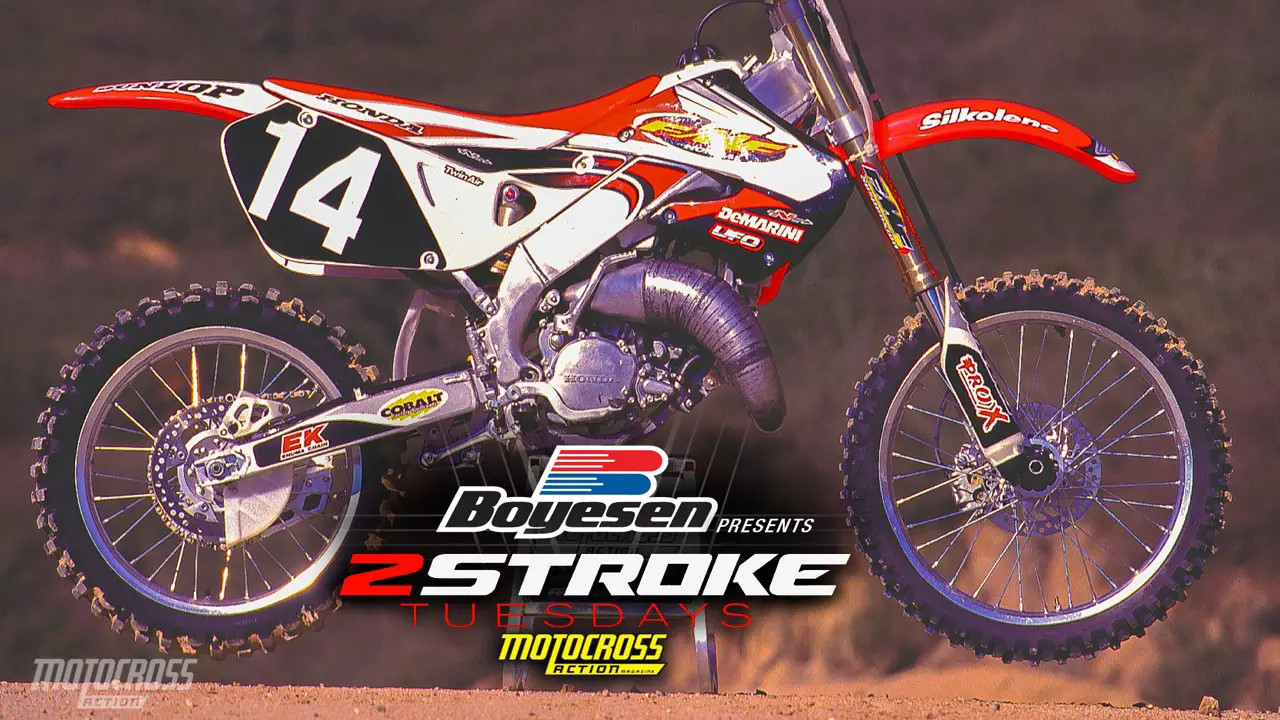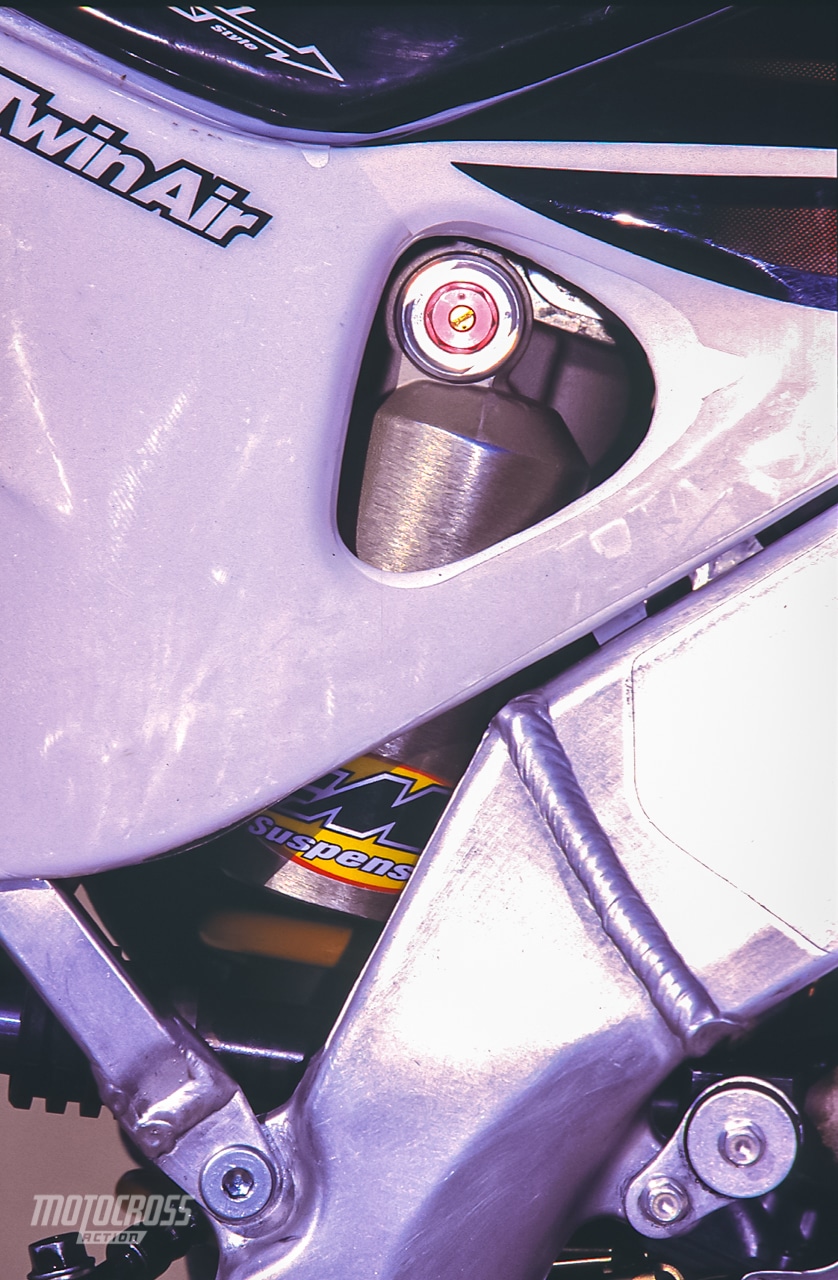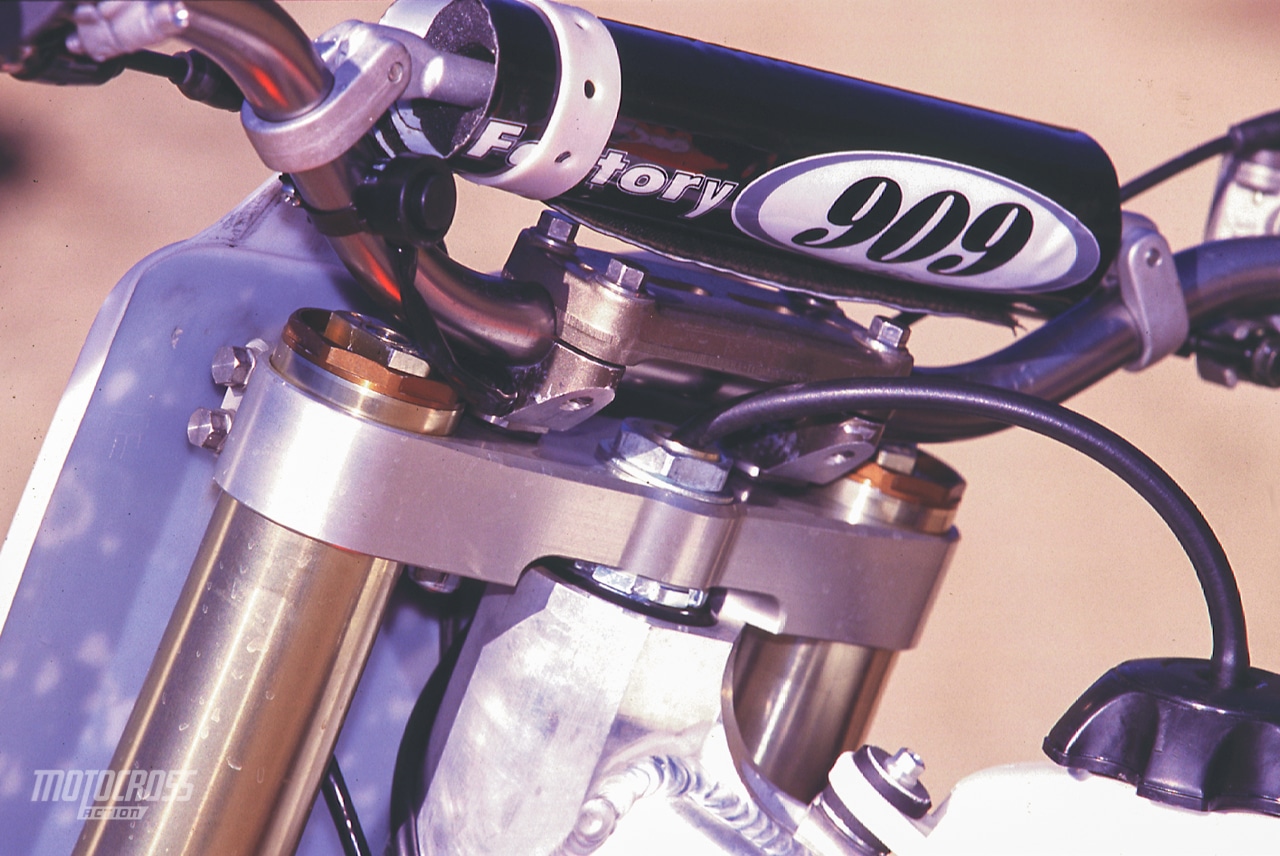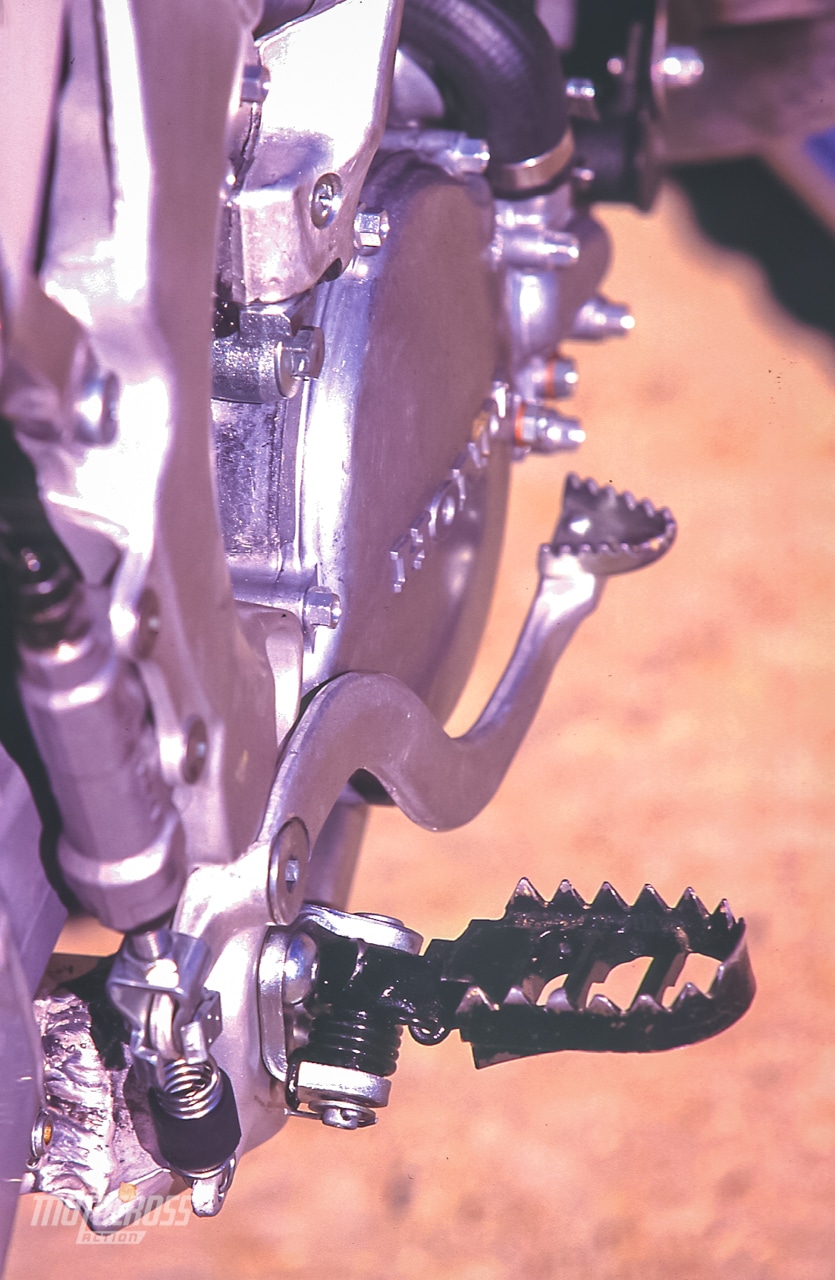TWO-STROKE TUESDAY | SCOTT SHEAK’S 1998 HONDA CR125
 This article was in the March issue of the 1998 Motocross Action Magazine.
This article was in the March issue of the 1998 Motocross Action Magazine.
“About 5pm yesterday, I was out at the HPCC track when I got the call to drive down to Glen Helen to meet the MXA test crew,” said Scott Sheak’s mechanic Tom Watson. HPCC is Honda’s top secret test facility, located out in the middle of nowhere (actually ten miles beyond the middle of nowhere). No one in a sound frame of mind would want to be at HPCC in the dead of the winter (even if Honda is paying him to be there). So the smile on Tom’s face couldn’t have been broader as he pulled into Glen Helen (which is not only warmer, but 100 miles closer to civilization). Why had the MXA test crew summoned Tom from the desert? To bring Scott Sheak’s new Team FMF/Honda CR125 to us.
WHAT’S THE FMF ENGINE LIKE?
With factory support from Honda, you would think that Honda’s resident engine builder Cliff White would have had his hands all over the FMF team’s engines. Well, you’d be wrong. Starting with Cliff’s best engines from ’97, FMF’s Terry Varner dove into the CR125 mill headfirst and came out with a engine that oozes usable horsepower.
“Last year, Reynard’s CR125 engine produced a lot of horsepower, but it wasn’t easy to ride. It was all peak. Terry Varner came up with a engine that makes incredible numbers on the dyno and delivers usable power on the track,” explained Tom–who should know since he was Robbie Reynard’s mechanic before moving to Sheak in ’98.

The worst part about the stock 1998 CR125 is it was a disappointing engine. The best part of the Honda/FMF bike was its impressive engine. This was the first Honda that had some bottom (albeit very little), tons of midrange and enough top end to get to the next corner. What else can we say, we liked it.
On the racetrack, it was clear that Sheak’s bike wasn’t a stock ’98 CR125. The stocker is all midrange, with no top end and no bottom. Sheak’s bike was what every CR125 should be. The FMF bike had just enough bottom to get the engine into the midrange, where it makes the meat of its horsepower (by meat we’re talking T-bone not dog food). Then once into the middle, the FMF CR125 did something that the ’98 stocker doesn’t want to do–rev. It doesn’t rev to the moon like older CR125’s, but with the amount and quality of midrange the bike has, catching gears will have you going faster than you ever wanted to go.
The stock CR125 falls off the pipe at least twice a lap, which requires a hardcore rider to fan the clutch to keep the bike going forward. Not Sheak’s CR125. It has enough midrange and top-end to pull every gear in the five-speed box. Equally noteworthy was that Sheak was not going for a hard hitting-style of power. His CR125 delivered its power in a very controlled, well-timed and manageable manner.
Can you buy the same motor that Scott Sheak uses? Yes. FMF plans to sell the engines right out from under their team riders. However, each of Team FMF/Honda’s four riders has his own unique likes and dislikes when it comes to power delivery. FMF plans to advertise what each of their riders likes and sell it to the consumer as a Pingree, Sheak, Sellards or McCormick model.
WHAT’S THE FMF SUSPENSION LIKE?
Surprise, the CR125’s stock Kayaba parts magically turned into Showa pieces. The stock Kayaba units are missing on Sheak’s FMF CR125 and in their place are Showa Kit components. These are the same forks that Factory Connection sells to the general public (only Sheak’s forks have been slightly altered by FMF’s suspension guru Rob Hendrickson). The forks start as stock ’98 CR250 forks, but the internals (cartridge rods and all) are replaced with the Showa aftermarket kits.
How do the Showa kit forks work? Superbly. They are plush, not only on the big landings that supercross delivers, but also over little bumps. The MXA test crew tested the Factory Connection kit last year and raved about its overall performance. They are stiff (because they have Supercross valving in them), but even then they still move.

Some things that factory teams do they do just because they can. Take for example the stock 1998 CR125 shock. Sure stock its to soft for Supercross but with a revalve by FMF’s Rob Hendrickson it would work just fine. Then why switch to a Showa shock? Because they could, nothing else.
Stock Honda CR125 forks suffer from a mild case of midstroke harshness, which rears its ugly head in the form of headshake (and at fourth gear wide open, no case of headshake is mild). With the Showa forks, the CR125’s headshake disappeared. Maybe it was better valving or the correct spring rates, but whatever it was we liked it. These are the best Honda forks made.
Why did FMF switch from Kayaba to Showa? FMF said they asked the same question of Honda team manager Wes McCoy and he replied, “Factory support”.
Can you do it? Yes, but it’s hard to imagine your average 125 pilot ripping his Kayaba’s off and replacing them with a set of ’98 Showa kitted forks. What would the forks cost? About $1500. That’s why you sign up with a factory team. For riders on a budget, FMF will offer Kayaba fork and shock mods priced for the average consumer.
What about the shock? It too was a Showa kit shock. Sheak’s shock was valved on the stiff end, but surprisingly not enough so that you couldn’t ride around a normal motocross track on it.
WHAT’S IT LIKE TO RIDE SHEAK’S CR125
Factory-backed bikes really shine (especially for the rider they are hand-built to suit). Scott Sheak’s personal set-up isn’t as off-the-beaten path as many big name rider’s bikes, but he does have his peccadilloes.
 FMF took the flaws out of the stock 1998 CR125, improved all the pluses threefold without creating any new flaws, pretty impressive.
FMF took the flaws out of the stock 1998 CR125, improved all the pluses threefold without creating any new flaws, pretty impressive.
Bars: The first thing you notice when you sit on Sheak’s bike is that his handlebar position has more in common with a stock pair of 1973 Elsinore 125 handlebars than with anything current. They are swept back on the ends, rotated back in the clamps and downright different from what most people are used to.
 Besides moving his handlebars 5mm back in the clamps, Sheak runs a set of cast works footpegs that move his footpeg position back 5 mm. It’s common for the factory boys to move their handlebar position and footpeg to fit their stature. What’s uncommon is that Sheak didn’t move his shifter back to compensate for the new footpeg position. The setup may work for Sheak but for us the new peg/shifter position made the Honda into the worst shifting 125 of the year.
Besides moving his handlebars 5mm back in the clamps, Sheak runs a set of cast works footpegs that move his footpeg position back 5 mm. It’s common for the factory boys to move their handlebar position and footpeg to fit their stature. What’s uncommon is that Sheak didn’t move his shifter back to compensate for the new footpeg position. The setup may work for Sheak but for us the new peg/shifter position made the Honda into the worst shifting 125 of the year.
Levers: Despite the fact that the clutch and brake levers are stock, the extra care Sheak’s mechanic Tom puts into them is evident in how strong the front brake is and how easy the clutch pull is. These things may not seem like much, but after pulling in the clutch lever and using the front brake during a thirty minute moto, every little bit helps. Scott runs his levers fairly high up on the bars. We had to reach up to grab them.
Shifting: The big shocker was that none of the test riders could get Scott Sheak’s bike to shift very well. After scratching our heads wondering how the best shifting 125 could become so bad, we noticed something amiss. Sure enough, Sheak doesn’t run stock footpegs (although he does run a stock shift lever). Scott’s 5mm wider works footpegs are moved back on the chassis. Why would Sheak want to move the footpegs back? That’s easy. Since Sheak isn’t the tallest rider on the planet, he has trouble getting back on the bike when going through whoops. Honda built special footpegs and works triple clamps that mount the bars five millimeters back (without changing the steering angle) to ease his transition to the back of the bike. It didn’t work for our feet, but it must for Scott’s.
Handling: The new CR125 alloy frame has a considerable amount of understeer, but Scott’s bike didn’t. It tracked straight, turned on a dime and didn’t have an iota of headshake. Most of these benefits come from the superior suspension components.
CAN YOU HAVE SCOTT SHEAK’S BIKE?
Want to make your bike a Sheak replica? Here’s what you’ll need:
(1) Start with N-Style team graphics. The quickest way to have a Team FMF/Honda bike is to make your bike look like one.
(2) After you ride with your new-looking FMF/Honda team bike, you will realize your gearing is all wrong. Time to buy that FMF Cobalt sprocket in the 52-tooth variety.
(3) With that new big rear sprocket, it’s best you get a new chain–FMF opts for EK Chain.
(4) After your first crash and bent set of handlebars, you’re ready for your next piece of the FMF/Honda puzzle–a set of FMF’s 909 handlebars. Most of the team uses #1966 (McGrath) or #1971 (Lammy) bends.
(5) Now you’re ready to dive into the pipe and silencer department. Pick up an FMF Fatty pipe and a “Bad News Barker” carbon fiber Power Core II.
(6) Next, have FMF tackle your forks. Sorry, they won’t be Showa’s (you’ll have to call Factory Connection for that), but the stock Kayabas can be made to work very well.
(7) Last, but not least, pick the engine tuning of your favorite FMF/Honda rider’s engine.
If you follow these seven steps, you can own a Scott Sheak replica.





Comments are closed.